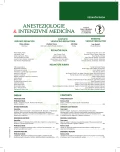Regional anaesthesia and haemostasis-modifying drugs – latest recommendations
Authors:
M. Jelínek
Authors‘ workplace:
Anesteziologicko-resuscitační klinika Fakultní nemocnice u svaté Anny v Brně
Published in:
Anest. intenziv. Med., 27, 2016, č. 6, s. 367-374
Category:
Overview
Performing regional anesthesia in patients receiving anticoagulants or antiplatelet medications includes higher risk of bleeding complications. Spinal epidural haematoma after neuraxial puncture represents the most serious complication. Many world-wide and national societies of anaesthesiologists have published their guidelines on the management of antithrombotic therapy in relation to regional anaesthesia. The aim of this article is to compare the current guidelines.
Keywords:
regional anaesthesia – neuraxial anaesthesia – spinal anaesthesia – epidural anaesthesia – anticoagulation – antiplatelet medications – guidelines – spinal haematoma
Sources
1. Tryba, M. Epidural regional anesthesia and low molecular heparin: Pro. Anasthesiol. Intensivmed Notfallmed Schmerzther, 1993, 28, 3, p. 179–181.
2. Moen, V., Dahlgren, N., Irestedt, L. Severe neurological complications after central neuraxial blockades in Sweden 1990–1999. Anesthesiology, 2004, 101, 4, p. 950–959.
3. Kalichman, L., Cole, R., Kim, D. H. Spinal stenosis prevalence and associated symptoms: the Framingham Study. Spine J., 2009, 9, 7, p. 545–550.
4. Vandermeulen, E. P., Van Aken, H., Vermylen, J. Anticoagulants and spinal-epidural anesthesia. Anesth. Analg., 1994, 79, 6, p. 1165–1177.
5. Horlocker, T. T., Wedel, D. J., Rowlingson, J. C. et al. Regional anesthesia in the patient receiving antithrombotic or thrombolytic therapy: American Society of Regional Anesthesia and Pain Medicine Evidence-Based Guidelines (Third Edition). Reg. Anesth. Pain Med., 2010, 35, 1, p. 64–101.
6. Gogarten, W., Vandermeulen, E., Van Aken, H., Kozek, S., Llau, J. V., Samama, C. M. European Scoeity of Anaesthesiology Regional anaesthesia and antithrombotic agents: recommendations of the European Society of Anaesthesiology. Eur. J. Anaesthesiol., 2010, 27, 12, p. 999–1015.
7. Breivik, H., Bang, U., Jalonen, J. et al. Nordic guidelines for neuraxial blocks in disturbed haemostasis from the Scandinavian Society of Anaesthesiology and Intensive Care Medicine. Acta Anaesthesiol. Scand., 2010, 54, 1, p. 16–41.
8. Harrop-Griffiths, W., Cook, T., Gill, H., Hill, D., Ingram, M., Makris, M., Malhotra, S., Nicholls, B., Popat, M., Swales, H., Wood, P. Regional anaesthesia and patients with abnormalities of coagulation: the Association of Anaesthetists of Great Britain & Ireland The Obstetric Anaesthetists‘ Association Regional Anaesthesia UK. Anaesthesia, 2013, 68, 9, p. 966–972.
9. Narouze, S., Benzon, H. T., Provenzano, D. A., Buvanendran, A., De Andres, J., Deer, T. R., Rauck, R., Huntoon, M. A. Interventional spine and pain procedures in patients on antiplatelet and anticoagulant medications: guidelines from the American Society of Regional Anesthesia and Pain Medicine, the European Society of Regional Anaesthesia and Pain Therapy, the American Academy of Pain Medicine, the International Neuromodulation Society, the North American Neuromodulation Society, and the World Institute of Pain. Reg. Anesth. Pain Med., 2015, 40, 3, p. 182–212.
10. Steinfeldt, T., Nimphius, W., Werner, T., Vassiliou, T., Kill, C., Karakas, E., Wulf, H., Graf, J. Nerve injury by needle nerve perforation in regional anaesthesia: does size matter? Br. J. Anaesth., 2010, 104, 2, p. 245–253.
11. Steinfeldt, T., Poeschl, S., Nimphius, W., Graf, J., Zoremba, M., Mueller, H. H., Wulf, H., Dette, F. Forced needle advancement during needle-nerve contact in a porcine model: histological outcome. Anesth. Analg., 2011, 113, 2, p. 417–420.
12. Neal, J. M., Brull, R., Chan, V. W., Grant, S. A., Horn, J. L., Liu, S. S., McCartney, C. J., Narouze, S. N., Perlas, A., Salinas, F. V., Sites, B. D., Tsui, B. C. The ASRA evidence-based medicine assessment of ultrasound-guided regional anesthesia and pain medicine: Executive summary. Reg. Anesth. Pain Med., 2010, 35, 2 Suppl., p. S1–9.
Labels
Anaesthesiology, Resuscitation and Inten Intensive Care MedicineArticle was published in
Anaesthesiology and Intensive Care Medicine

2016 Issue 6
Most read in this issue
- Depth of anaesthesia monitoring
- Thrombophilic conditions during pregnancy
- Regional anaesthesia and haemostasis-modifying drugs – latest recommendations
- Preventive immobilisation of the cervical spine in pre-hospital emergency care in trauma patients: update
